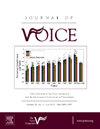Emotional Adjustment in Children with Vocal Fold Nodules
IF 2.5
4区 医学
Q1 AUDIOLOGY & SPEECH-LANGUAGE PATHOLOGY
引用次数: 0
Abstract
Introduction
Vocal fold nodules (VNs) in children are benign, bilateral, callous-like lesions at the junction of the anterior third and posterior two-thirds of the true vocal folds. Chronic, repetitive, and intense vocal behavior is often cited as the primary etiology; however, difficulties with emotional adjustment may predispose some children towards extreme and possibly phonotraumatic vocal activity, thereby contributing secondarily to the development of VNs.
Objectives
This case-control study examined the association between features of emotional adjustment and VNs in children.
Methods
Parents of children with VNs (N = 40, Mage = 7.5, SDage = 2.03) and two medical control groups [ie, voice disordered, but not VNs (VDCs; N = 40, Mage= 7.09, SDage = 2.01) and vocally normal controls (VNCs; N = 40, Mage = 7.6, SDage = 1.54)] participated in the study. Features of emotional adjustment were assessed using two inventories: the Parent Rating scale for Reactive and Proactive Aggression and the Revised Child Anxiety and Depression Scale – Parent version.
Results
As compared with the VNCs, children with VNs were significantly more aggressive (P = 0.042, Cohen's d = 0.47) whereas the VDCs were more depressed (P = 0.013, Cohen's d = 0.60). Furthermore, VDCs experienced more separation anxiety than VNs (P = 0.038, Cohen's d = 0.45) and VNCs (P = 0.021, Cohen's d = 0.55). No other significant between-group differences were identified between the VNs and VDCs.
Conclusions
When present, elevated aggression may represent a risk factor for VNs formation in children, and possibly influence treatment outcomes. Therefore, the current results highlight the importance of understanding the role of emotional adjustment in the evaluation and treatment of dysphonia in children.
患有声带褶皱结节的儿童的情绪适应问题。
导言:儿童声带小结(VNs)是位于真声带前三分之一和后三分之二交界处的良性、双侧、胼胝样病变。慢性、重复和强烈的发声行为通常被认为是主要病因;然而,情绪适应困难可能会使一些儿童倾向于极端的、可能是声音创伤性的发声活动,从而继发 VNs:本病例对照研究探讨了儿童情绪调节特征与 VNs 之间的关系:方法:患有 VNs(N = 40,Mage = 7.5,SDage = 2.03)的儿童的父母和两个医学对照组[即嗓音失调,但无 VNs(VDCs;N = 40,Mage = 7.09,SDage = 2.01)和嗓音正常对照组(VNCs;N = 40,Mage = 7.6,SDage = 1.54)]的父母参加了研究。研究人员使用两个量表评估了儿童的情绪适应特征:反应性和主动性攻击家长评定量表和修订版儿童焦虑抑郁量表(家长版):与 VNC 儿童相比,VN 儿童的攻击性明显更高(P = 0.042,Cohen's d = 0.47),而 VDC 儿童的抑郁程度更高(P = 0.013,Cohen's d = 0.60)。此外,VDC 比 VN(P = 0.038,Cohen's d = 0.45)和 VNC(P = 0.021,Cohen's d = 0.55)经历更多的分离焦虑。VNs 和 VDCs 之间没有发现其他明显的组间差异:如果存在攻击行为,攻击行为的增加可能是儿童 VNs 形成的一个风险因素,并可能影响治疗效果。因此,目前的研究结果强调了了解情绪调整在儿童发音障碍的评估和治疗中的作用的重要性。
本文章由计算机程序翻译,如有差异,请以英文原文为准。
求助全文
约1分钟内获得全文
求助全文
来源期刊

Journal of Voice
医学-耳鼻喉科学
CiteScore
4.00
自引率
13.60%
发文量
395
审稿时长
59 days
期刊介绍:
The Journal of Voice is widely regarded as the world''s premiere journal for voice medicine and research. This peer-reviewed publication is listed in Index Medicus and is indexed by the Institute for Scientific Information. The journal contains articles written by experts throughout the world on all topics in voice sciences, voice medicine and surgery, and speech-language pathologists'' management of voice-related problems. The journal includes clinical articles, clinical research, and laboratory research. Members of the Foundation receive the journal as a benefit of membership.
 求助内容:
求助内容: 应助结果提醒方式:
应助结果提醒方式:


